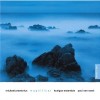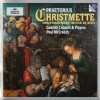Composers
Michael Praetorius (probably February 15, 1571 – February 15, 1621) was a German composer, organist, and music theorist. He was one of the most versatile composers of his age, being particularly significant in the development of musical forms based on Protestant hymns, many of which reflect an effort to improve the relationship between Protestants and Catholics.
He was born Michael Schultze, the youngest son of a Lutheran pastor, in Creuzburg, in present-day Thuringia. After attending school in Torgau and Zerbst, he studied divinity and philosophy at the University of Frankfurt (Oder). After receiving his musical education, from 1587 he served as organist at the Marienkirche in Frankfurt. From 1592/3 he served at the court in Wolfenbüttel, under the employ of Henry Julius, Duke of Brunswick-Lüneburg. He served in the duke's State Orchestra, first as organist and later (from 1604) as Kapellmeister.
His first compositions appeared around 1602/3. Praetorius had begun writing some of them when Regensburg was the parliamentary seat of the Holy Roman Empire. Their publication primarily reflects the care for music at the court of Gröningen. The motets of this collection were the first in Germany to make use of the new Italian performance practices; as a result, they established him as a proficient composer.
These "modern" pieces mark the end of his middle creative period. The nine parts of his Musae Sioniae (1605–10) and the 1611 published collections of liturgical music (masses, hymns, magnificats) follow the German Protestant chorale style. With these, at the behest of a circle of orthodox Lutherans, he followed the Duchess Elizabeth, who ruled the duchy in the duke's absence. In place of popular music, one now expected religious music from Praetorius.
When the duke died in 1613 and was succeeded by Frederick Ulrich, Praetorius retained his employment. From 1613 he also worked at the court of John George I, Elector of Saxony at Dresden, where he was responsible for festive music. He was exposed to the latest Italian music, including the polychoral works of the Venetian School. His subsequent development of the form of the chorale concerto, particularly the polychoral variety, resulted directly from his familiarity with the music of such Venetians as Giovanni Gabrieli. The solo-voice, polychoral, and instrumental compositions Praetorius prepared for these events mark the high period of his artistic creativity. Until his death, Praetorius stayed at the court in Dresden, where he was declared Kapellmeister von Haus aus and worked with Heinrich Schütz.
Michael Praetorius died on his 50th birthday, in Wolfenbüttel, Germany and is entombed in a vault beneath the organ of St. Mary's Church there.
His family name in German appears in various forms including Schultze, Schulte, Schultheiss, Schulz and Schulteis. Praetorius was the conventional Latinized form of this family name.
Praetorius was a prolific composer; his compositions show the influence of Italian composers and his younger contemporary Heinrich Schütz. His works include the nine volume Musae Sioniae (1605–10), a collection of more than twelve hundred (ca. 1244) chorale and song arrangements; many other works for the Lutheran church; and Terpsichore (1612), a compendium of more than 300 instrumental dances, which is both his most widely known work, and his sole surviving secular work.
The familiar harmonization of Es ist ein Ros entsprungen (Lo, How a Rose E'er Blooming) was written by Praetorius in 1609.
Praetorius was the greatest musical academic of his day and the Germanic writer of music best known to other 17th-century musicians. Although his original theoretical contributions were relatively few, with nowhere near the long-range impact of other 17th-century German writers, like Johannes Lippius, Christoph Bernhard or Joachim Burmeister, he compiled an encyclopedic record of contemporary musical practices. While Praetorius made some refinements to figured-bass practice and to tuning practice, his importance to scholars of the 17th century derives from his discussions of the normal use of instruments and voices in ensembles, the standard pitch of the time, and the state of modal, metrical, and fugal theory. His meticulous documentation of 17th-century practice was of inestimable value to the early-music revival of the 20th century.
His expansive but incomplete treatise, Syntagma Musicum, appeared in three volumes (with appendix) between 1614 and 1620. The first volume (1614), titled Musicae Artis Analecta, was written mostly in Latin, and regarded the music of the ancients and of the church. The second (De Organographia, 1618) regarded the musical instruments of the day, especially the organ; it was one of the first theoretical treatises written in the vernacular. The third (Termini Musicali, 1618), also in German, regarded the genres of composition and the technical essentials for professional musicians. An appendix to the second volume (Theatrum Instrumentorum seu Sciagraphia, 1620) consisted of 42 beautifully drawn woodcuts, depicting instruments of the early 17th century, all grouped in families and shown to scale. A fourth volume on composition was planned, with the help of Baryphonus, but was left incomplete at his death.
Praetorius wrote in a florid style, replete with long asides, polemics, and word-puzzles – all typical of 17th-century scholarly prose. As a lifelong committed Christian, he often regretted not taking holy orders but did write several theological tracts, which are now lost. As a Lutheran from a militantly Protestant family, he contributed greatly to the development of the vernacular liturgy, but also favored Italian compositional methods, performance practice and figured-bass notation.
Praetorius' most recognizable piece from Terpsichore, "La Bouree," became part of current popular culture in several ways, including as part of the song, "Ding-Dong! The Witch is Dead" by The Fifth Estate, first appearing on their album "The Rub-a-Dub," released in 1967 by Jubilee Records. "La Bouree" was also played as the 7 AM time signal every weekday morning throughout the 1980s on WCPN, Cleveland's NPR radio station. Several of his works have been used in the soundtrack of the popular Sid Meier game Civilization IV.
Recently Added
| Country: | Germany |
| Period: | Renaissance, Baroque |
Biography
Michael Praetorius (probably February 15, 1571 – February 15, 1621) was a German composer, organist, and music theorist. He was one of the most versatile composers of his age, being particularly significant in the development of musical forms based on Protestant hymns, many of which reflect an effort to improve the relationship between Protestants and Catholics.
He was born Michael Schultze, the youngest son of a Lutheran pastor, in Creuzburg, in present-day Thuringia. After attending school in Torgau and Zerbst, he studied divinity and philosophy at the University of Frankfurt (Oder). After receiving his musical education, from 1587 he served as organist at the Marienkirche in Frankfurt. From 1592/3 he served at the court in Wolfenbüttel, under the employ of Henry Julius, Duke of Brunswick-Lüneburg. He served in the duke's State Orchestra, first as organist and later (from 1604) as Kapellmeister.
His first compositions appeared around 1602/3. Praetorius had begun writing some of them when Regensburg was the parliamentary seat of the Holy Roman Empire. Their publication primarily reflects the care for music at the court of Gröningen. The motets of this collection were the first in Germany to make use of the new Italian performance practices; as a result, they established him as a proficient composer.
These "modern" pieces mark the end of his middle creative period. The nine parts of his Musae Sioniae (1605–10) and the 1611 published collections of liturgical music (masses, hymns, magnificats) follow the German Protestant chorale style. With these, at the behest of a circle of orthodox Lutherans, he followed the Duchess Elizabeth, who ruled the duchy in the duke's absence. In place of popular music, one now expected religious music from Praetorius.
When the duke died in 1613 and was succeeded by Frederick Ulrich, Praetorius retained his employment. From 1613 he also worked at the court of John George I, Elector of Saxony at Dresden, where he was responsible for festive music. He was exposed to the latest Italian music, including the polychoral works of the Venetian School. His subsequent development of the form of the chorale concerto, particularly the polychoral variety, resulted directly from his familiarity with the music of such Venetians as Giovanni Gabrieli. The solo-voice, polychoral, and instrumental compositions Praetorius prepared for these events mark the high period of his artistic creativity. Until his death, Praetorius stayed at the court in Dresden, where he was declared Kapellmeister von Haus aus and worked with Heinrich Schütz.
Michael Praetorius died on his 50th birthday, in Wolfenbüttel, Germany and is entombed in a vault beneath the organ of St. Mary's Church there.
His family name in German appears in various forms including Schultze, Schulte, Schultheiss, Schulz and Schulteis. Praetorius was the conventional Latinized form of this family name.
Praetorius was a prolific composer; his compositions show the influence of Italian composers and his younger contemporary Heinrich Schütz. His works include the nine volume Musae Sioniae (1605–10), a collection of more than twelve hundred (ca. 1244) chorale and song arrangements; many other works for the Lutheran church; and Terpsichore (1612), a compendium of more than 300 instrumental dances, which is both his most widely known work, and his sole surviving secular work.
The familiar harmonization of Es ist ein Ros entsprungen (Lo, How a Rose E'er Blooming) was written by Praetorius in 1609.
Praetorius was the greatest musical academic of his day and the Germanic writer of music best known to other 17th-century musicians. Although his original theoretical contributions were relatively few, with nowhere near the long-range impact of other 17th-century German writers, like Johannes Lippius, Christoph Bernhard or Joachim Burmeister, he compiled an encyclopedic record of contemporary musical practices. While Praetorius made some refinements to figured-bass practice and to tuning practice, his importance to scholars of the 17th century derives from his discussions of the normal use of instruments and voices in ensembles, the standard pitch of the time, and the state of modal, metrical, and fugal theory. His meticulous documentation of 17th-century practice was of inestimable value to the early-music revival of the 20th century.
His expansive but incomplete treatise, Syntagma Musicum, appeared in three volumes (with appendix) between 1614 and 1620. The first volume (1614), titled Musicae Artis Analecta, was written mostly in Latin, and regarded the music of the ancients and of the church. The second (De Organographia, 1618) regarded the musical instruments of the day, especially the organ; it was one of the first theoretical treatises written in the vernacular. The third (Termini Musicali, 1618), also in German, regarded the genres of composition and the technical essentials for professional musicians. An appendix to the second volume (Theatrum Instrumentorum seu Sciagraphia, 1620) consisted of 42 beautifully drawn woodcuts, depicting instruments of the early 17th century, all grouped in families and shown to scale. A fourth volume on composition was planned, with the help of Baryphonus, but was left incomplete at his death.
Praetorius wrote in a florid style, replete with long asides, polemics, and word-puzzles – all typical of 17th-century scholarly prose. As a lifelong committed Christian, he often regretted not taking holy orders but did write several theological tracts, which are now lost. As a Lutheran from a militantly Protestant family, he contributed greatly to the development of the vernacular liturgy, but also favored Italian compositional methods, performance practice and figured-bass notation.
Praetorius' most recognizable piece from Terpsichore, "La Bouree," became part of current popular culture in several ways, including as part of the song, "Ding-Dong! The Witch is Dead" by The Fifth Estate, first appearing on their album "The Rub-a-Dub," released in 1967 by Jubilee Records. "La Bouree" was also played as the 7 AM time signal every weekday morning throughout the 1980s on WCPN, Cleveland's NPR radio station. Several of his works have been used in the soundtrack of the popular Sid Meier game Civilization IV.


















![Great European Organs. 42-Kristian Olesen [Roskilde Cathedral]](http://static.classicalm.com/repository/collection-cover/small/923-img1341921804741048.jpg)
![Great European Organs. 49-John Kitchen [Reid Concert Hall, Edinburgh]](http://static.classicalm.com/repository/collection-cover/small/937-img1342098961448895.jpg)


